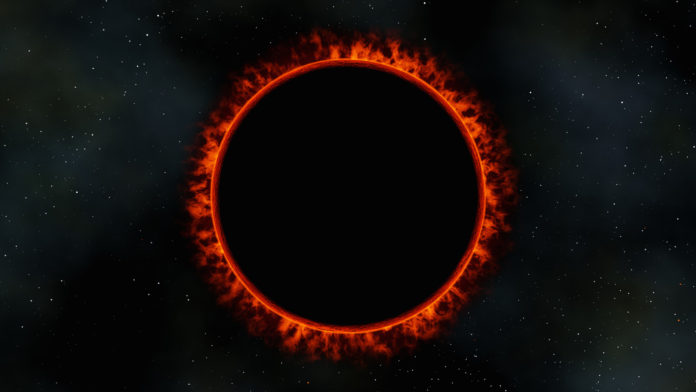Using advanced algorithms and data-cleansing techniques, a team of scientists, led by solar physicist Craig DeForest, discovered structures in the outer corona that had never been seen before. The way in which they discovered these structures was by analyzing a series of images taken by NASA’s STEREO spacecraft.
The outer corona is what’s responsible for the existence of solar winds which themselves are very complex and have magnetic fields embedded within. But how does it get this complex? To answer this question, the scientists took to analyzing observations of the outer corona in great detail.
First, the team looked at coronagraph images that were generated by NASA’s Solar and Terrestrial Relations Observatory-A (STEREO-A) spacecraft. They knew that STEREO-A would be passing behind the sun in around April 2014 and they wanted to gather some data before any disruptions to their communications occurred.
So, a 3-day data collection campaign was organized during which time COR2 (the chronograph on STEREO-A) captured much longer and more frequent images of the corona than normal. These long exposures allow the scientists to capture details they would otherwise miss. But, they also wanted higher resolution images, so they needed a new direction. Turning to software instead, they took to improving the chronograph’s signal-to-noise ratio.
The signal-to-noise ratio measures how well you can determine the signal from that of the noise. COR2’s chronograph works in a similar way to your hearing in that it is sensitive enough to detect and produce very detailed images of the corona, but these images are shadowed by noise. In order to get an accurate image of the outer corona DeForest and colleagues first had to boost the signal-to-noise ratio.
To do this, they had to develop complex algorithms (comparable to
advanced online casino algorithms) in which truly separate the corona from all the background noise. They also had to filter out light from any background stars. Once this had been done, the scientists had to apply corrections for the length of time the camera’s shutter was open for and adjust the brightness of the images. But, one of the most challenging obstacles the team faced was motion blur caused by solar wind. The team had to develop a special algorithm just to smooth out their images in time.
Smoothing images in time is similar to the action of when you do a “double-take” (i.e. you have a quick second glance to make sure you saw what you saw), but it takes the process one step further by transforming this idea into an algorithm.
In order to undo motion blur from the solar wind, the scientists estimated the speed it was traveling and shifted the images at the same rate. To determine the exact amount to shift the images by, the team had to move the images pixel-by-pixel to compare them with one another and look for their similarities. They determined that the amount of shift corresponded to an average solar speed of around 136 miles per second. “We smoothed, not just in space, not just in time, but in a moving coordinate system,” says DeForest. “That allowed us to create the motion blur that was determined not by the speed of the wind, but by how rapidly the features changed in the wind.”
The most surprising part of the project wasn’t in finding any specific structure, it was simply that they found something. For a long time, scientists had been under the impression the corona was smooth, but this latest study reveals that’s not the case at all. “When we removed as much noise as possible, we realized that the corona is structured, all the way down to the optical resolution of the instrument,” said DeForest.
Another remarkable discovery which unfolded as part of the study was the fact that coronal streamers (the bright structures with enhanced magnetic properties that form over regions of the Sun) are far more structured than the scientists realized. “What we found is that there is no such thing as a single streamer,” explains DeForest. “The streamers themselves are composed of myriad fine strands that together average to produce a brighter feature.”
To find where a corona ends and where a solar wind begins, scientists often look for what’s known as the Alfven surface. The Alfven surface is a theoretical boundary where solar wind travels faster than waves can move backward through it. “Material that flows out past the Alfven surface is lost to the Sun forever,” says DeForest.
Physicists used to believe that the Alfven surface was a flat layer where solar wind accelerated to a critical speed. However, following DeForest’s research, that’s starting to change. “What we conclude is that there isn’t a clean Alfven surface. There’s a wide ‘no man’s land’ or ‘Alfven zone’ where the solar wind gradually disconnects from the Sun, rather than a single clear boundary.”
The team’s observations revealed quite a patchy find where some plasma is moving so fast it stops backward communications, while other streams close by are not. They also discovered something else quite odd: “We found that there’s a correlation minimum around 10 solar radii,” said DeForest. At this distance, pretty much all images fail to match up properly. But they become better again at greater distances, so it’s obviously not just the distance from the Sun that’s affecting the correlation.
These insights provide scientists with an inkling of what’s to come from the Parker Solar Probe mission. Set to gather measurements from inside the outer solar corona, this mission will be the first of its kind. In total, the spacecraft will travel to a region that’s around 8.86 solar radii where lots of interesting finds are just waiting to be found (hopefully). Using their results, DeForest predicts there will be “steep fluctuations in density magnetic fluctuations and reconnection everywhere, and no well-defined Alfven surface.”

